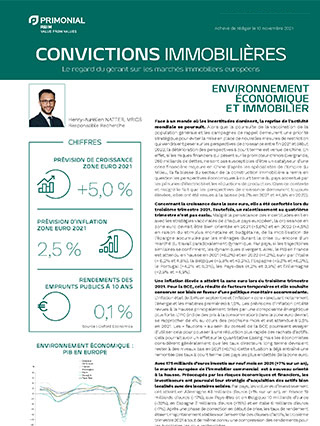- Home
- Studies and research
- Real estate convictions : 2021 overview
Real Estate Convictions Europe : 2021 Overview
After a year in 2020 affected by the economic shock of Covid-19, 2021 brought a vigorous economic recovery which created supply-chain bottlenecks.
Although the global economic recovery is continuing, 2022 has already brought the first of its own economic challenges: disrupted supply chains, high inflation, record debt. Uncertainties include the impact of the Omicron variant -- which seems to have milder symptoms -- questions over the adoption of the massive ‘Build Back Better’ stimulus programme in the USA, the continued weakness in the Chinese real estate sector and the risks associated with a possible conflict between Ukraine and Russia. For the time being, the global economy is expected to grow by 4.4% in 2021 and 3.8% in 2022.
The recovery in the Eurozone continued in the fourth quarter of 2021. Economic activity is likely to remain strong in 2022, but a slowdown is to be expected in 2023. Eurozone growth is likely to be strong in 2022, at 4.0%, but then slow to around 2.7% in 2023. A similar trend is expected in each member state. GDP growth in Spain is expected to be 5.5% in 2022 and then 4.3% in 2023, followed by Italy (4.4% then 2.5%), Germany (3.9% and 2.9%), France (3.7% and 2.3%), the Netherlands (3.5% and 2.1%), and Belgium (3.0% and 1.4%).
Imbalances between supply and demand contributed to high levels of inflation in the fourth quarter of 2021. In the ECB’s eyes, the increase in inflation mainly reflects a sharp increase in oil, gas and electricity prices. Inflation was 5.0% in December, with core inflation (excluding energy prices in particular) of 2.8%. The consequences of imbalances between supply and demand in several sectors have been particularly visible in the price of goods and consumer services. The CPI (consumer price index) in the Eurozone is expected to rise 2.6% over 2022 as a whole. Despite the ECB’s reworking of its asset purchase plans (QE) at the end of 2021, key long-term interest rates are likely to remain low in 2022, but in positive territory, at 0.5%.
With €318 billion invested in 2021 (up +23% year-on-year), the return to growth in the European commercial real estate market1 was confirmed. Investors continued their strategy of buying ‘core’ buildings which were concentrated (62%) in office and residential real estate. In the major economies, investment volumes reached €95 billion in Germany (up 43% over a year), €71 billion in the UK (48%), €30 billion in France (-13%), €15 billion in the Netherlands (-31%), €12 billion in Spain (+23%) and €10 billion in Italy (+17%). Yields were stable overall across all asset classes in the fourth quarter of 2021, which nevertheless saw a compression in returns for the most sought-after asset types.
1 Commercial real estate refers to office, retail, logistics, service and residential real estate for institutional investors
Sources for figures: CBRE, FMI, RCA, Oxford Economics.

The team

Henry-Aurélien Natter joined Praemia REIM as Research Manager in January 2018. He has the mission of developing the analyses of the Research & Strategy Department on the real estate markets, the economy and capital in France and in Europe.
Henry-Aurélien Natter began his career at Les Echos Etudes (formerly Eurostaf), then at C&W (formerly DTZ), and lastly at BNP PRE, where he acquired solid and varied experience in real estate research, strategy and finance. He is qualified with an AES degree in Business Management, a Masters Decree in management and SME management, and an International Master in commerce and marketing.
You may also like

- Market review
Real Estate Convictions : Q4 2024
The continued reduction in ECB interest rates, the level of savings amongst Europeans and the recovery of the real estate markets between 2022 and 2024 all point to the potential for improvement and a rebound in the sector.

- Market review
Real Estate Convictions : Q3 2024
In October 2024, the ECB announced its third consecutive rate cut to ease its restrictive monetary policy, and we believe that a new momentum has opened up for the European real estate market. Indeed, this quarter we have seen a thaw in certain real estate indicators.

- Market review
Real estate convictions : 1st quarter 2024
For now, European real estate professionals have been cautious and are watching for the tipping point that could occur with the announcement of the first change in direction by the ECB.


 et Firefox
et Firefox 